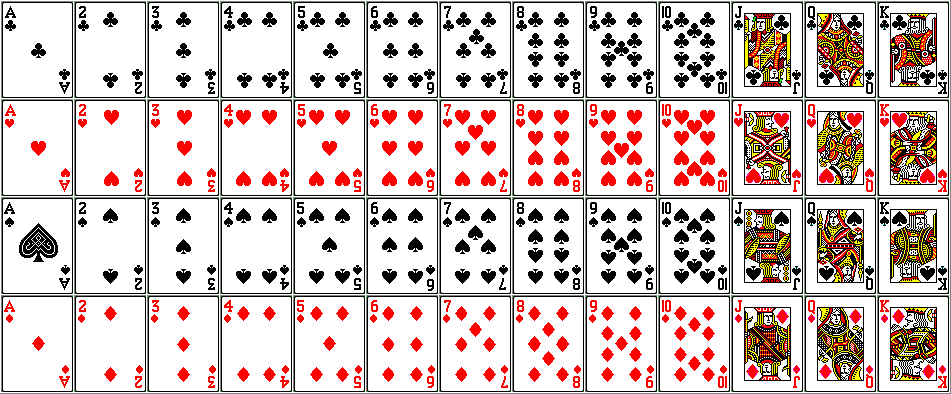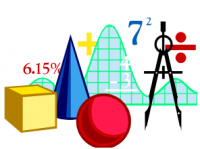Timetable › Forums › Standard › Probability & Relative Frequency › Cards
Tagged: Cards, probability
-
AuthorPosts
-
Playing Cards

A standard deck has 52 cards
• 26 red cards (hearts and diamonds)
• 26 black cards (clubs and spades)
• There are 4 suits – 13 cards in each:
– hearts
– diamonds
– clubs
– spades• Each suit has an Ace, 2, 3, 4, 5, 6, 7, 8, 9, 10, Jack, Queen, King
• Picture or Court Cards: Jack , Queen King
From an ordinary pack of 52 playing cards Michael chooses a card. Find the probability that the card is:
a. A nine.
b. A red nine.
c. A red card.
d. A red card or a nine.
e. Not a nine.a. P(Nine) = $$\frac{4}{52}$$
$$=\frac{1}{13}$$b. P(Red Nine) = $$\frac{2}{52}$$
$$=\frac{1}{26}$$c. P(Red) = $$\frac{26}{52}$$
$$=\frac{1}{2}$$d. P(Red or 9) = $$\frac{28}{52}$$ (there are 26 reds and 2 black 9’s – don’t double count the red 9’s as both reds and 9’s) $$=\frac{7}{13}$$
e. P(not Nine) = $$\frac{48}{52}$$ (there are 4 9’s so that means there are 48 not 9’s)
$$=\frac{12}{13}$$Four cards are drawn, without replacement, from a standard pack of playing cards. What is the probability that:
a. Each suit is chosen?
b. All are the same suit?a. consider all the cases where the Heart is chosen first: there are six ways this can happen, each with the same probability hdsc, hdcs, hcsd, hcds, hsdc, hscd
$$[\frac{13}{52}\times\frac{13}{51}\times\frac{13}{50}\times\frac{13}{49}]\times 6$$ $$=\frac{2197}{83300}$$
now this could also happen with diamonds first, or clubs or spades so there will be 4 lots of $$\frac{2197}{83300}$$
P(each suit) =$$\frac{2197}{83300}\times 4$$
$$=\frac{2197}{20825}$$
b. P(same suit) = P(hhhh) + P(dddd) + P(ssss) + P(cccc) $$=[\frac{13}{52}\times\frac{12}{51}\times\frac{11}{50}\times\frac{10}{49}]\times 4$$
$$=\frac{44}{4165}$$
All the hearts and black aces are removed from a standard pack of cards. If a card is drawn at random from the remaining cards, find the probability of drawing:
a. A red card.b. An ace.
if all the hearts are removed – that leaves 39 cards and then remove two black aces, that leaves 37 cards 13 red cards left, and only one red ace
a. P(red) = $$\frac{13}{37}$$
b. P(Ace) = $$\frac{1}{37}$$
A card is chosen at random from a regular pack of playing cards. What is the probability that the card is:
a. Red?
b. A club?
c. A queen?
d. A black?
e. The queen of hearts?
f. Not a spade?a. P(Red) = ½ half are red and half are black, so probability of red = ½ b. P(club) = ¼ there are four suits: hearts, diamonds, clubs, spades – each suit has equal chance of ¼ c. P(Queen) = $$\frac{4}{52}$$
$$=\frac{1}{13}$$there are 4 queens out of 52 cards d. P(Black) = ½ half are red and half are black, so probability of black = ½ e.P(Queen Hearts) = $$\frac{1}{52}$$ there is only osince ¼ are spades, then ¾ are not spades f. P(not Spade) = ¾ since ¼ are spades, then ¾ are not spades Two cards are drawn successively at random (without replacement) from a pack of playing cards. You may assume that the pack has 52 cards of four suits. What is the probability that:
a. The first card drawn is a spade?
b. Both cards are spades?
c. Both cards are the same suit?a. P(spade) = ¼ there are four suits: hearts, diamonds, clubs, spades – each suit has equal chance of ¼ b. P(spade spade) = $$\frac{13}{52}\times\frac{11}{51}$$ $$=\frac{1}{17}$$ there are 13 spades so the probability of the first one is 13 out of 52, now there will only be 12 left out of 51 for the second one c. P(same suit) = P(ss) + P(hh) + P(dd) + P(cc) $$=\frac{13}{52}\times\frac{11}{51}+\frac{13}{52}\times\frac{11}{51}+\frac{13}{52}\times\frac{11}{51}+\frac{13}{52}\times\frac{11}{51}$$ $$=\frac{4}{17}$$ we must think of all the cases where we get the same suit: 2 spades, 2 hearts, 2 diamonds, 2 clubs and add all of these probabilities A card is drawn at random from a standard pack of 52 playing cards. Find the probability that : a. The card is not a diamond b. The card is a “number” card and is divisible by three. a. P(not diamond) = ¾ one quarter are diamonds, so three quarters are not diamonds b. P(number divisible by 3) = $$\frac{12}{52}$$ $$=\frac{3}{13}$$ the cards divisible by 3 are: 3, 6 and 9 there are 4 of each type = 4 × 3 = 12 -
AuthorPosts
- You must be logged in to reply to this topic.



